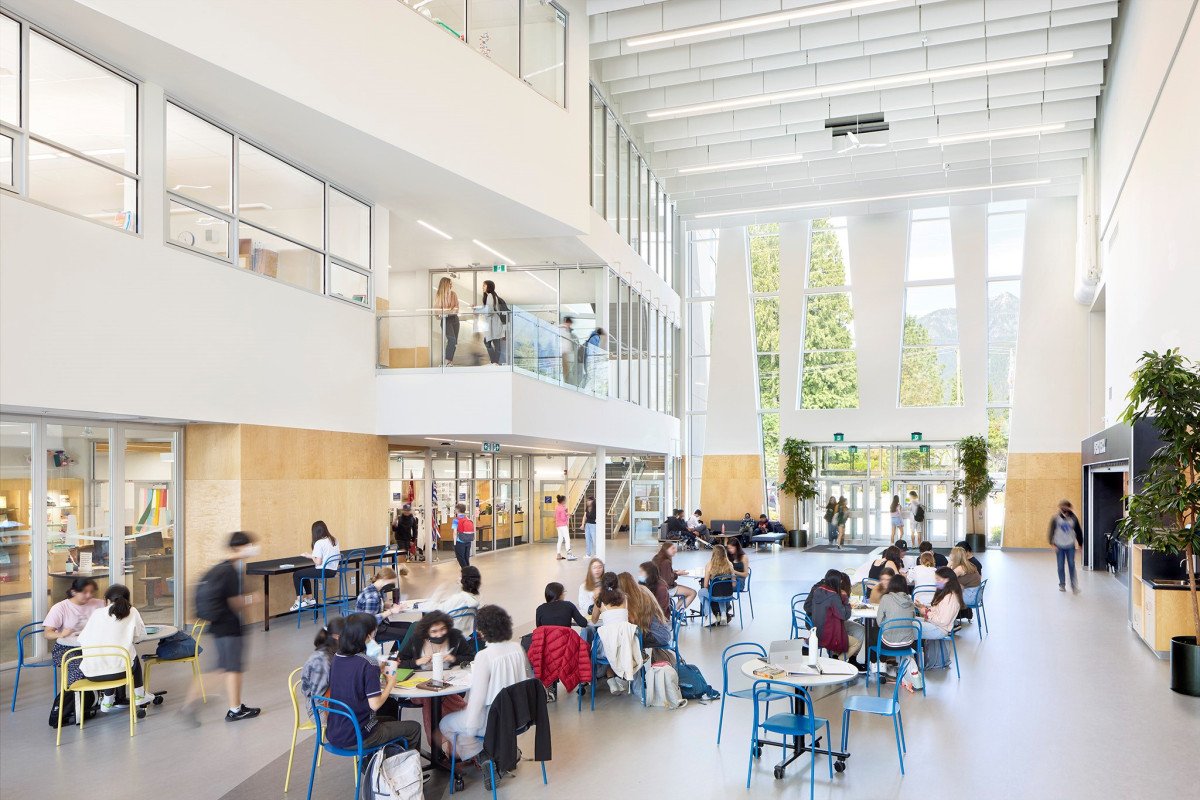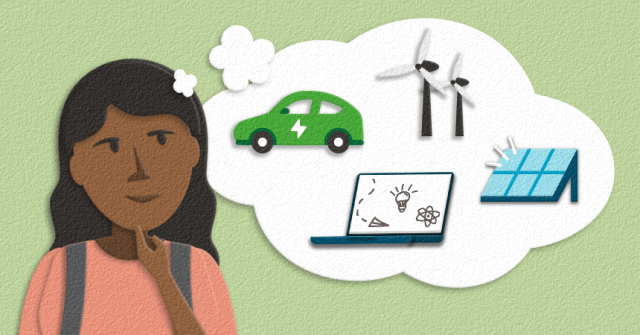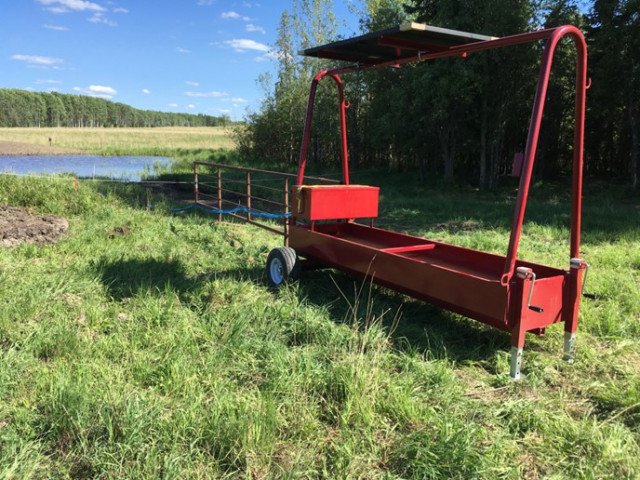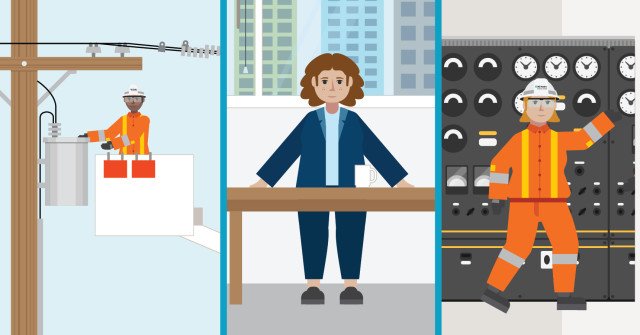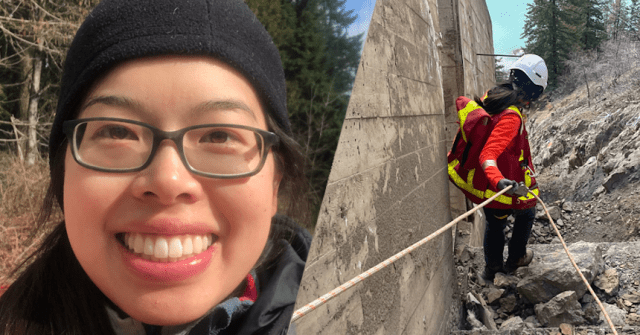It’s one thing to design and build schools to deliver comfort, energy savings, and emissions reductions. It’s quite another thing to operate them effectively so that costs are in check and that students, teachers, and staff are happy.
While delivering significant CO2 reductions, annual operating costs at Argyle and Handsworth secondary schools in North Vancouver have increased by only 17% and 10% respectively. This is a small price to pay for the greatly improved buildings with their vast array of new offerings and amenities for students.
Luke Smeaton, the North Vancouver School District’s (NVSD) manager of sustainability, energy and environmental planning, says the traditional process of getting building systems operating “as intended” is only a starting point because the nuances of occupant needs and system performance aren’t really known until people move in and start using the building.
“You might get staff commenting that a space is too warm and something’s wrong with the building,” he says. “But then you investigate and find a gigantic photocopier or laptop charging carts placed where they were not anticipated. The system may be doing what the designers intended, but that might not align with what the occupants actually need.”
Occupant education is also a very important aspect of high performance building operation. That’s why staff at Argyle and Handsworth got a quick-start guide to explain the systems in place at the new schools. Staff need to know, for instance, that while the school’s displacement ventilation system can provide some level of cooling as the school year heads toward summer, the system does not deliver full air conditioning.
“When people first move into a new building, it’s easy for misinformation to float around,” he says. “So, we provide training and information to manage occupant expectations and help them work with the building, not against it.”
Smeaton recognizes the huge team effort required to build new schools. “We appreciate everyone that contributes to NVSD projects and are excited to continue our clean energy journey as we create more healthy, safe, and inclusive learning environments,” he says.
Hybrid heating systems will save a combined 230 tonnes of CO2 at two schools
The NVSD first took the bold step of employing integrated design and bringing a hybrid heating system – a combination of electric heat pumps and gas boilers – to cut emissions in a new secondary school project in 2007. But lessons learned there, including the importance of efficient building envelopes and careful consideration of occupant needs, have upped the ante in the school district’s fight against carbon emissions.
Exhibits A and B are new buildings for both Ecole Argyle Secondary and Ecole Handsworth Secondary schools, which aren’t just thrillingly bright and modern places of learning. Hybrid heating systems at both schools are helping save a combined 230 tonnes of C02 per year compared to the previous buildings.
That’s a 48% emissions reduction at Handsworth, which was one of the district’s biggest emitters of CO2, and 37% at Argyle for a combined CO2 savings equivalent to taking 50 gas-powered cars off the road. For its commitment at the two school and beyond, NVSD has been named a BC Hydro Clean Energy Champion.
“As an organization, we're really committed to reducing carbon emissions,” says NVSD’s Smeaton. “We’ve always had environmental considerations front and centre, in everything we do. The tagline for our school district is ‘The natural place to learn’, and our strategic plan identifies environmental stewardship as one of six key goals for the organization.”
The ideas in play at the NVSD are catching on. After Smeaton gave a presentation on the design of the new Handsworth to BC Hydro’s energy manager network last year, he’s had calls from other school districts asking that he present directly to their capital project teams.
What they’ll be hearing from Smeaton is an explanation of the NVSD’s approach to new builds and how projects have harnessed clean and renewable BC Hydro electricity so far. And how they’re about to embark on an even more ambitious project: an all-electric elementary school.
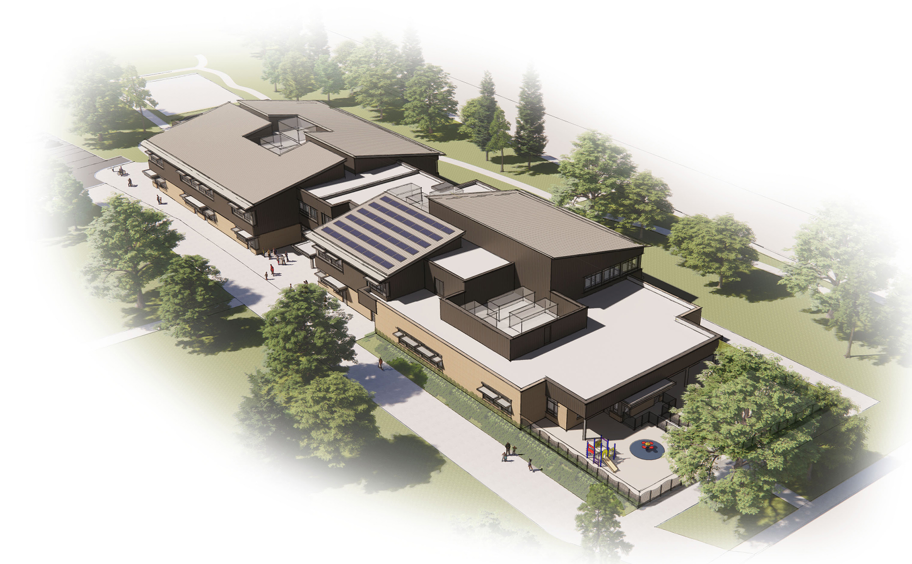
An elementary school in the Cloverley neighborhood, due for opening in 2026, will be the boldest North Vancouver School District project to date, an all-electric school that employs both electric heat pumps and electric boilers – along
with solar power generation – to reduce greenhouse gas emissions. (Photo courtesy DA Architects + Planners)
New elementary school designed to have 85% fewer GHG emissions
Demolition and site preparation on the Cloverley neighbourhood project has already begun, with a new $64 million school utilizing mass timber structural elements due to open in September 2026.
The school is designed to be all-electric, with greenhouse gas emissions targeted to be 85% below that of a typical school.
The use of heat pumps with electric boiler backup will be a big differentiator at the new elementary school, which will have the capacity for 585 students. The project also includes a BC Ministry-funded Neighbourhood Learning Centre, and a child care centre funded separately through an application to the ChildCareBC New Spaces Fund and $3.5 million from the City of North Vancouver.
"I've always had a thing for heat pumps"
By the time Smeaton joined the school district seven years ago, he was already well-versed in energy efficiency and decarbonization initiatives aimed at moving buildings away from reliance on fossil fuels. He worked for years as an energy and sustainability consultant and his experience with sustainable technologies reaches way back to his childhood.
“I’ve always had a thing for heat pumps,” says Smeaton. “I'm from New Zealand, and my dad was a refrigeration technician while I was growing up. In the late 80’s, I helped him install one of the first residential heat pumps under our house. I actually did a school project that was basically a business case comparing a heat pump to a wood stove, first costs, running costs, etc. So it's funny that I ended up as an energy manager now.”
Once Smeaton got on the sustainability train, he had little interest in jumping off, consulting on innovative sustainable building projects in New Zealand, Australia, and the UK, before coming to Canada.
Power Smart for Schools activities that explore clean energy
Here are a few in-class activities that zero in on clean energy choices and their applications. You may want to start with our video primer on what electrification means to our future.
Describing clean energy (Grade 12)
Students decide which physics concepts are the most useful when explaining why certain methods of generating electricity are cleaner than others.
Water cycle and hydroelectricity (Grade 2)
Students watch a video and build a model turbine to learn how electricity in B.C. depends on the water cycle.
Energy transformations and hydroelectricity (Grade 4)
Using a real-world example from B.C., students learn the hydroelectric system and how it works.
Energy transformations: wind power (Grade 4)
After watching a short, animated video, students share their notes in small groups and discuss what they know about wind energy and energy transformations.
Energy transformations: solar energy (Grade 4)
Students watch a video about solar energy and two different technologies that convert solar energy into other energy forms, then test their knowledge of solar energy with the “Solar: fact or fiction?” worksheet.
Our clean energy (Grades 4-7)
Through research, students explore how different ways electricity can be generated and how these different methods impact the environment.
What is renewable energy (Grades 4,5,7)
Get students thinking about the six types of renewable energy introduced in this short video and recap the information heard in groups and as a class.
